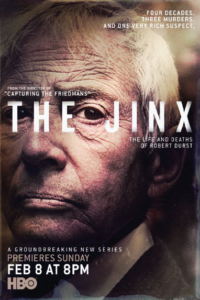 There are people in this world who will kill you if you inconvenience them. Such people are walking among us, right here in our community, the opportunity to ply their particularly lethal proclivities may not have presented itself. They’ve just not been inconvenienced enough.
There are people in this world who will kill you if you inconvenience them. Such people are walking among us, right here in our community, the opportunity to ply their particularly lethal proclivities may not have presented itself. They’ve just not been inconvenienced enough.
Whether billionaire real estate heir Robert Durst is one of those people will eventually be decided in the town where celebrity criminal trials are commonplace – Los Angeles. And his motivations for the alleged nasty wrongdoing will be debated by some of the best legal minds in the country. Money will be no object in his defense, and the media will feast with reports on a perpetual cycle.
But the role of the media leading up to Robert Durst’s second arrest for murder, this time for the 2000 execution-style killing of crime writer Susan Berman, will prove to be integral to the prosecution. The meaning of Durst’s words, which were picked up by a microphone gaffe, “What the hell do I do? Killed them all, of course,” is already being vigorously discussed. Was this conversation he was having with himself in a bathroom an admission? Do you tell yourself the truth? Do you often play out things and debate differing scenarios with yourself in the mirror? Some of us would ask whether Durst can even stand to look at himself in the mirror in the first place.
For those of you who don’t know what I’m talking about, here’s the thumbnail: Robert Durst, 71, is the son of New York City real estate mogul Seymour Durst. This makes him an heir to a huge real estate fortune. And Durst is suspected of killing three people – his first wife, who disappeared in 1982; his longtime friend Susan Berman, who was murdered in Los Angeles; and a neighbor in Galveston, Texas, while Durst was in Texas incognito, disguised as a woman. Well, Durst admitted killing and dismembering that poor soul (in self-defense) in Texas and a jury couldn’t convict him.
A recent HBO documentary series from director Andrew Jarecki, titled “The Jinx: The Life and Deaths of Robert Durst,” has reignited the investigation of Durst. This investigation has led to Durst’s arrest for the murder of Berman due in no small part to a conversation Durst had with himself in a bathroom while his microphone was still hot. Among other possibly incriminating statements, Durst uttered the words, “Killed them all, of course.” Prosecutors will spin those words into an admission of guilt, but defense attorneys will play it the other way.
Legally, motions to suppress these incriminating statements will be filed by Durst’s multimillion dollar defense team. His gifted defense attorney, Dick DeGuerin (who successfully defended him in Galveston), has already started the public narrative and caused me to refer to the black eyed man as “Bob.” I kid you not, in “The Jinx,” Durst’s eyes are as black as coal. Of course, this may be because the documentarians used minimal lighting and the same kind of cameras that I use in my documentary work. But the manner in which he was captured and presented fits the description of “steely-eyed killer.” And don’t kid yourself, Oscar-nominated filmmaker Jarecki, who utilized various cameras (including reportedly-ancient HDV tape ones) to achieve a noticeably “crunchy” video look, knew exactly what he was doing.
But, in the end, the law may not be with the defense, and the statements may come into evidence at a trial of the case. A documentary crew, even one that may later share information with the authorities, are not necessarily bound by the Constitutional requirements as interpreted by the ground-breaking United States Supreme Court cases in 1964 (Escobedo v. Illinois) and later in 1966 (Miranda v. Arizona). Durst was never read his rights. At one point earlier in the documentary series, an attorney purporting to represent Durst can be seen advising him that his microphone is still on, while he was muttering to himself.
If the statements are not suppressed by the Judge in the case in Los Angeles, the defense may take a similar approach to the one pursued successfully in Galveston. That defense, “The Media Made Him Do It,” would argue that the documentary filmmakers manipulated Durst into questioning his own innocence. And this could be combined to an attack on the technological and storytelling approaches filmmaker Jarecki and his team employed in making Durst look more like a monster than he might otherwise have appeared had the images been better lit and lensed. Call it the “Crunchy Video Steely-Eyed Killer Defense.” This case will be the topic of much discussion and debate in the coming months.
As the Durst case unfolds, lessons will be learned, starting with, the killer might be next door. So, try not to inconvenience him.
Editor Note: This article first appeared in print and online at the Times-Herald.

